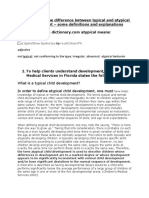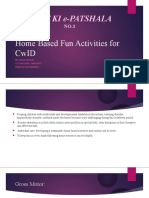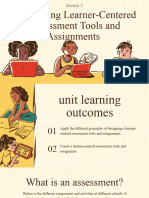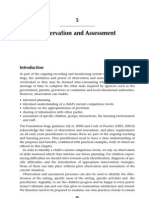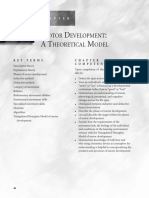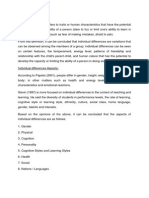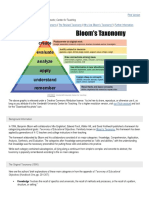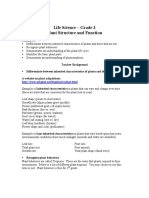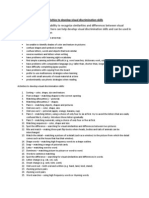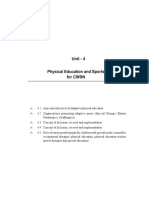0 ratings0% found this document useful (0 votes)
225 views15 pagesHuman Development Lecture
Uploaded by
Jethro OrejuelaCopyright
© © All Rights Reserved
We take content rights seriously. If you suspect this is your content, claim it here.
Available Formats
Download as PDF or read online on Scribd
0 ratings0% found this document useful (0 votes)
225 views15 pagesHuman Development Lecture
Uploaded by
Jethro OrejuelaCopyright
© © All Rights Reserved
We take content rights seriously. If you suspect this is your content, claim it here.
Available Formats
Download as PDF or read online on Scribd
You are on page 1/ 15
‘PROFESSIONAL EDUCATION
Ud
OVERVIEW OF HUMAN DEVELOPMENT
mmprised of stages.)Each stage of
‘Human development is a a " ks
development has markers which indeate students’ abilities to perform varouS task
5 about Human Development
to environr
Nature- Is development due to Nurture- Is ‘development — : —_
Stage- Is development change Continous s deepen ange ada)
Culture- Does development proceed diferenty
niversal the
[sameway roy wee" proceed In he) ferent cultures? ana
i ' i tions- Are children’s behaviours determi
Taiteente sb nati | Sanh Bn coea a?
i " i ir significant’ roles in
- Their | Passive- Do children play insi
oun devSopmet? Bly mp in he [Pe Geapmen?
it Tong- | Transient Effects-Do.early experiences, have
[kang ets Do ge xaos ave lon) phat lrmeets upon deveapment?
A. Basic Concepts
* In biological sense, is tn deta tors cra human beings) that leads
inevitably to their death. Development does involve growth in early life, stability in early
adulthood, and the declines associated with aging in later life.
« Refers to the emotional bond children normally form with those who"eare for them
a ar oe xs ia haan sual
leves these specific goals:
1. Helps the infant
2 ts be in wit a 5 ST ate vn
3. Helps the child regulate his/her emotions
* John Bowlby focused on how attachment difficulties were transmitted from one
2» Seraton tothe next
‘Summary of Great Debate:
: unless other applicable law, maturity is attained earlier
* Concems the process of growth and maturation f the human individual fom conception
* Development is best understood within a lifespan perspective) with growth and change
beginning at conception and throughout childhood and adolescence and, in some
‘respects, during adulthood and old age,
Child and Adolescent Development
* Referto the process of growth and maturation of the human individual from conception to adulthood.
WU oa Les Exmiatn fr Pestana Tethers (LEFT) Revewer
Scanned with CamScanner
. PROFESSIONAL EDUCATION
tho patem of Boogie, cognte, an
ee 1 Socloematona Changes that begins at conception ad
ost velopment involves grvth,athouny
. » although it.
Ok series of ordery, cohere ventually invoh cay (yng).
a erie cortttonalandeaegays k 7
es,
sonality (Maier, 1969) Which,
: weclie iltaonof on change make up an Individual’ ever developing
ad
«fst he surounding condition tat itis
+ Althe external physical and social congj evelopment
ae ‘tions and el
rs to stimulating sock i vents that can atte
uaters| Ing Social interactions ns that can affect us, rom crowded living
Growth, cal 1
- REPORTER Rb bend ding Muatdhenahlngeey ebdigas
‘occur from concept
tody an be Measure atthe tape, om, stu seo te
Pentel Me Sef dan ition “heght wit,
cof heredity im Parents to offspring through genes, the basic units
F 88 through which experience brings about relatively
Tl te a
‘raion
» Consists of
+ Usualy considered to be genetically programmed: the result of heredity
+ The biological unfolding ofan individual accord
ic ing to plan conta
rater passed from parens to chid at conception, Se
‘Sociohistoric- Cognitive/ Linguistic Theory
« (ev SemanovichVygotsky’s belief that the chi sc dened a he ei ts
evelopment is concemed as depen
: ’ t
+ Wdeas based on observations and other kinds of evidences which ae organized ina systematic
‘inamer—
* Used to explain and predict the behaviors and development of children and adults
+ Boost pil tvoconertyach the child acquires new kil and information withthe bp”
et jult peer ;
4 fluenced
|. Growth and devolopment are the result of both nature and nurture, They ae
by a combination of ganetic, biological, environmental, and experiential fac in
individual child's progression through the ‘developmental stages is the result of @ unique mx
af physical and mental predispositions and atbuts, 25 well 2s environmental conitons,
ptessona Teaches rn Review EERE
PRU Board Licensure Examination fr
Scanned with CamScanner
ee
PROFESSIONAL EDUCATION
vt
Such as poverty, prenatal drug exposure, or empath parenting,
Wea conn cs trot wit evoment in te te hg Pn
roceed evenly across domains in a paral! fasion (e.g, language evelopment
‘imes outstrip physical development or vice versa) ‘ maya
nent is progressive over time. It unfolds in a series of stageg in a cy
‘sequence, Though each individual develops in a unique way, the SeRUENE ode tt
consistent for all individuals, For example, in general, children gain cont oot
bodies from head to toe and from the center out Falberg, 1991, “tei
Some degree of variation around what is considered the normal te for an inci
Compete a developmental task should still be considered within the noma range, The
"oral variations wuld be smaller inthe case of an infant in a period of rap
‘development, but might be as much as six months for an adolescent. For example, fe
brain and body growth before age two makes infants highly susceptible tp malate
Which if not corected, can lead to brain damage, intellectual disability, andor south
telardation,
5. For most individuals, growth and development occur within a family or family
context. Thus, the parent figures are the ones who are Primarily responsibi
the child has needed supports
impede di is
le for sein et
for development and is protected from conditions that: Would
imental proces
ad cognitive The effects of maltreatment on development are the r
Complex interaction of factors, including nature, duration,
developmental stage ofthe child; need; physical and psyc!
and environmental and interpersonal conditions that act
individuals who are victims of maltreatment, or who
Normal development, it is Important to understand of
Within each domain at each stage and what can suppo
©. BASIC ISSUES IN HUMAN DEVELOPMENT
sult oa
and severity of matteatnene
chological constitution ofthe ci
3 to increase oF mitigate risk For
have conditions that may handicap,
ptimum developmental possibies
oF impede optimum development.
believing that it Hint.
to teach them to behave inp
ae
ean Tyas)». nko C668 agus mater wat ot
Tohn (wcke’
that they were Sag
an intuitive understanding of right and wrong, and that they would develop in pos
rections as long as society dd not interfere with their natural tendencies
# maintained that an infantis a tabula ras, ora blank slat, waling tobe
witten on by his o her own experienc sas
G
a fers to heredity and biologically based dispositions
includes learning, experiences, child-rearing methods, societal changes ard
culture Sac e
3. Activity and Passivity”
a ~ ofchestrate their own development by exploring the world |
b ~ belngs who are largely products or forces beyond their contohus”
AU Board censure Examinaon or Professonal Teachers @LEPT) Reviewer
Scanned with CamScanner
_inomerat ine ‘PROFESSIONAL EDUCATION
4 inuity and Discontinuity
leorists view
out sudden changes, "= evelopment as pores tat ocusinsma st
* Discontinuity eo py :
the course og T
8, each of indivi c/¢#¥onmentas more tke sees of stair.
5 : Divo ane ethic 4
Wins
Chien mst acu sts nessa
‘forthe development of cher skis 7
ven Bou peda am ene
‘banter
mane att ol bet ater | tor Tm nbaSSpoNTSe
‘smal ons can put ogee {he same rate of evelopment,
Growth and size and development of motor The directions of human, it
contol take place ina. cephalocaudal ‘mse cnsdre pag
Sg itil decttn, notr conti | te bectiden bees
ako taking a pinot or ri fo
xtites dein
The orp gos a5 tao sang a [Te dion Su ena
tat ete by ipay a |or gpd te nae en
resources, enthusiasms and interest.
‘At certain limited time in this development, | The tatty development is more critical |
th crparism is ast ab oma use | an ee evepret er sta
xunenect ropes | so nerie
inert cetan abe ener and
expres
Growth buds upon te agar ta | Deep mer he pons a xp
‘efter ‘tem andcte tiling erty
some cont
Diferent measures of grow ‘ils ae needed hte
i ‘ opment of mare
en = eee
sehmibtits |} |,
eiRacesoetoe | hes en
‘sues by individual, andy he wo sees. | each indi
Pit Board Lensre Examination fr Potessonal teachers LET Reviews: EEL
Scanned with CamScanner
ause it is the product of several processes.
al, cognitive and socioemotional
EA The Processes
Rema nesses the brain, gain i
ological processes underlie the
Changes in motor skils, and puberty’s hormonal changes. cena
Cognitive processes involve the ng ch imagine how
» developmental processes enable a growil "
to sole 2 math problem, come up with a creative strategy, or speak meaningfully
connected sentences. i
4,
ERNIE che ality. Parents’ nurturance toward
“people; changes in emotion, and changes in persona e
a child, a boy's aggressive attack on a peer, a girl's ere aoe
and an adolescent’ feelings of joy after getting good grades
| processes in development.
E.2. The Periods
Erte ier unaeeen sy
Physical Developement
Peale
| conception to birt’
‘ith at fl tem about 18 | Locomotion established: rudimentary lanquage;,
months social attachment
‘bat 18 mons to about 6 | Language well estabished, sex typing: group play;
years ends with adiness for schooling
ses become adult oxcopt In
team play.
‘About 6 to about 13 years | Many cognitive
speed of operation, a
‘About 13 to aout 20 years | Bogins with puberty ends a
of highest level of cognit
is; Sewwal elatonships
‘About 20 to about 45 years ily development
‘Aout 45 to about 65 years
Ss highest Tevel:” self-assessment,
feticement?
‘About 65 years to deat | Enjoys family achievements; dependency,
\widowhond; poor healt
F._Stagos of Human Development
These pertain tothe numberof pried in a mans ie cycle. Although the focus of discussion
' is on individuals of school age, a ‘otic 7
‘also given, 496, @ brief description of thase in other stages of development
1 (renal Stage conception)
~The prenatal period in many aspects
's considered as one of the most- i nat
the most important period of all In he of the most- if no
" ,Soncepton and ens at ith and apransfa ot 8 Beton. Tis person begins at
approxim: is
calendar months.Prenatal period is divided ino ee ee ae ee
4 Germinal Stage Gfertiizaton to 2 weeks)
: TiS ao aown ashe erlod of the zygote, |
© Zygote refers to the new cel
a ft i
Col dis epee Meh so oa ae e689 Cl and the
ina time nolo r
SERENA 4d ttt ese zation,
vels down to the
Scanned with CamScanner
PROFESSIONAL EDUCATION
{alloplan tube and then to the uterus where the Implantation begins.
‘weeks to 2 months or 8 weeks)
Also known as the period of tho embryo, The cell known as zygote before is
now known as embryo,
Hd the 14th day after fertilization, the blastocyst is already implanted in the
erus.
The ‘umbilical cord attaches the placenta functionally to the mother
‘This period is considered as the most critical period for the reason that the
embryo Is most vulnerable to damage and defect
¢. Fotal Period (@ weeks to birth}
* Also called as the period of the fetus. The embryo before is now known as
a in this stage. The fetal stage begins with the formation of the first bone
ce
Various organs grow functionally and take the appearance of the human body.
The fetus can now kick and can manipulate its extremities (upper and lower)
and can open its mouth, frown, and tum its head, as well as take a few
“breaths” by the end of the third ‘month.
incy Stage (birth-two weeks of life)
Infancy is the transition period intervening between birth and two weeks of life
and identified as the shortest of all developmental period.
© The word “infant” suggests extreme helplessness,
* Subdivisions of Infancy include the a) Period of the partunate or from the time the
fetal body has emerged from the mother's body and lasts until the umbilical cord has
been cut and tied; and the b) period of the neonate or from the cutting and tying of
the umbilical cord to the end of the second week of the postnatal life
‘© Most often, he is asleep, drowsy, cries, and gets excited easily.
‘* The neonate is sensitive to brightness as indicated by his papillary response to
change in illumination, his visual images are likely to be blurred because of failure of
the lens to focus on the object .
‘* The roots of language are crying, cooing and babbling.
. Babyhood Stage (2nd week to second year of life) )
Compared to infancy, babyhood stage is characterized by decreasing dependency for
‘the reason that this is the time when babies achieve enough body control to become
independent.
* Developmental tasks include: learning to walk, learning to take solid foods, having
organs of elimination under partial control, achieving reasonable psychological
stability especially in hunger rhythm and sleep, relating emotionally to parents and
siblings, and learning the foundations of speech
* Babyhood skills fall under two categories: hand skills and leg skill:Crying, cooing,
babbling, gesturing and emotional expressions are examples of prespeach forms of
‘communication.
‘* Common emotional patterns Involve anger, fear, curiosity, joy and affection.
Considered non-moral due to their lack ofa scale of values and conscience and they
demonstrate obedience to rules without question
aoe he ge ae palm oF oblsame ey apres
Names given to describe
age, pre-gang age, exploratory and the questioning age
PNU Board Licensure Examination for Professional Teachers (BLEPT) Reviewer
Scanned with CamScanner
SIONAL EDUCATION ; ; -
PROFESS! ‘* Developmental tasks include: control of elimination, self-feeding, self-dressing and
doing some things without much help, development of motor skills that alow him to
explore and do things to satisfy his curiosity and acquisition of adequate Vocabulary
to communicate his thoughts and feelings wi a national
* Early childhood is also characterized by heighte A
. The presence of the significant others or the primary group is also given importance
because they serve as models for the child who usually identifies with them and
atterns his behavior after them. | | |
. the preschool child should be given as much as physical experience as possible and
play activities to lear by doing and to develop his intellectual capacity.
«© This stage is also regarded as the teachable moment for acquiring skills because
children enjoy the repetition essential to learning skills; they are adventuresome and
like to try new things and have already learned skills to interfere with the acquisition
of the new ones. |
* Because speech development advances rapidly this time, as seen in the improvement
in comprehension as well as in the different speech skills, talking to young children
will leave a strong impact. -
+ The concept of morality emerges as a result of interactions with adults and peers.
5. Early Childhood Stage (two to six years of life)?
tatechltaed i weed fearing the basic skills in if. -
It coincides'with the child's elementary school years, entering Grade 1 at six years
and graduating at age 12.
‘© Names used to describe the stage are: troublesome age, sloppy age, quarrelsome
age, elementary school age, critical period in the achievement drive, gang age and
age of conformity.
* Physical growth is at slow and relatively even rate because of the influence of health,
nutrition, immunization, sex and intelligence.
* Children in this stage win recognition by being able to do things.
* Developmental tasks include: learning physical skills necessary for group and
organized games; learning to gt along with age-mates and members of hs family
/ and community; learning fundamental sks in reading, writing and numeracy;
situations; make decisions and solve problems,
* There is a rapid increase in understanding and inthe accuracy of concepts during
is Stage as a result of increased i!
leaning opt Inteligence and partly as a result of increased
Derived from the Latin wore 2 —
© The word growth spurt ie ote rapid fe
mse Pid acceleration
of
* Manifested in both tiem ee
and secondary sex charactegg at CMNGES nthe boy with both the primary
ioe
a
Scanned with CamScanner
* Primary sex characteristics ing rete tate
flow and the nocturnal omissions cto fete ort fat menstrual
+ Secondary sex characteristics on the ne :
which distinguish males ‘from fer :
members of the opposite sex.
* Puberty is the divided into
other hand include the physi
Physical features |
males and may be the source of appeal among the
ty develope (b) pubescent — characterized by menarche for
in boys, (c) post pubescent — secor
indary sex characters
developed and the sex organs begin to function ina rain nerate Pevame wel
7, ‘Adolescence Stage (thirteen or fourteen to eightoen years fie)
egowone is the age when the individual becomes integrated into society of!
the age when the chil
Batibo anew ne no longer feels that he is below the level of his elders
ramen ear amet
‘oughly from thirteen to sixteen or seventeen years, and
late adolescence covers the period then until eighteen, the age of legal maturity
* The developmental tasks of adolescence are focused onthe developing independence
in preparation for adulthood and in establishing a sense of identity.
* Adolescence is a period of heightened emotional a time of “storm and stress”.
* The important social changes in adolescence include increased peer-groupnfluence,
‘more mature patterns of social behavior, new socal groupings and new values inthe
selection of friends and leaders and social acceptance.
+ Relationships between adolescents and members of ther families tend to deteriorate
in early adolescence though these relationships often improve a adolescence grows
to close, especially among adolescent girls and their family members
© Have increased ability to engage in mental manipulations and test Hypotheses;
thinking becomes more abstract, beral and knowledge
8. Adulthood Stage (twenty to sixty-five years of life)
The need for love and intimacy are met in adult life, becomes more fufling in
marriage, with the involvement of commitment
© The need for generativity is through achievement
Burn out and alienation become a problem with work.
> Moral development possesses responsiblity forthe welfare of others.
ine upon growing olde.
© Changes in the primary senses an¢
the organ reserve deci
© Menopause for women and climacteric for men signiy
reproduction.
9
9, Old Age (sixty-five years of life) = —
. ne eae in these late years ‘begin to show slow, physical, intellect ane?
jal activites. =
. Ge there is a a declit tao eer Ht jer people see art and
ature ina deeper, more apprecaNe WAY. vs amet,
. lity, which Include Severe memory 10S ra
ee ond sonality change occurs because of dementia, @ sang
Cae ntelctal functioning afte adulond,aiation needs are ma
than achievement needs.
the decline of sex and
¥
Leensure Examination for Profesional Teachers queen reviewer EX
lll
Scanned with CamScanner
NU Board
1
ii PROFESSIONAL EDUCATION Canad Fy
(Theorie) ila ' He wry oF 1 porens
. 1, Freud's Psych ; nancy eB bis diy
. Freue iychosexual 7 .
In Freud's view, human behavior and psychological functioning were motivateg by
two basic drives: sexuality and aggression.
‘Centr of pleasure: mouth (major source of gratficatons and exploratony
ane &
Primary need: socunty — aycut, Liph | toa gea
Major conflict: weaning
2 Aad TT to3 ylo | Source of pleasure: anus and bladder (sensual satisfaction and sey
conto)
Major conflict: tole raining
id's genital (masturbation
‘to 8y/0 | Canter of pleasure: chi’ gen
Sebel " Major confit: Oedipus and Electra Complex
4. Latency | 6 y/o to puberty | Energy directed to physical and intellectual activities
Sexual impulses repressed
Relationship between peers of same sex
5. Genital | Puberty onwards | Eneray directed towards full sexual matty ‘and function and
_| development ot skls to cope withthe environment
Freud also conceptualized the personality as having three parts:
* The id, which exists from birth and Is most prominent in the newborn baby, is the
‘Subconscious part. It is related to the individual's most basic needs and wants, such as
the desire for food.
* The egois the rational, conscious part. t begins to emerge later in infancy and helps the
child relate to the realities of the environment and the constraints imposed by others,
without losing a healthy concept of self. For example, a young child cannot always be
fed exactly when hunger strikes, but older toddlers who are well cared for will learn to
wait a reasonable time for food, without losing trust that their hunger will be satisfied,
Birth to 1% y/o
Superego, which can be overly harsh and estraining.
2. Erikson’s Stages of Psychosocial Development Theory
what led psychosocial theory, Erikson not only put
Sexual and aggressive impulses into a larger context, but also added adult stage8
[? the course of development, thus becars i
iomon aca cceament th ing one of the first to view character
In each developmental stage,
Crisis, must be faced and new skills
{sto reséive the crisis Successfully
development in the future. His
Which a biologically ordered pla
develop fully.
“3 stags
», Erikson Said, a cer
s ntral conflict, or psychosoci:
acquired in the proc ee
: t 88. The more able an individual
ed the more likely he or she is to experience healthy
: eiethetl the epigenetic Principle, according to
¢ followed Systematically for an individual to
Scanned with CamScanner
PROFESSIONAL EDUCATION
= Bith fo 18 ‘Mistrust, withdrawal,
Tusts. Mistust Learn to! Sstrangement
1.bfncy
jo loss of self-
coy [1 8 8] Astron. Sane = Samal, st eat or
Gatowt yo and Ay coperte ard ines ar ence
Tap Lack of set-confgence
© | teams to Pessimism, ear ot
gate 3to 5y/o | initiative vs. Guilt Ability: one’ wrongdoing
ri-tood ‘own beh Over-contol and over-
a | restriction
SES TREEB Ysa
manipulate being mediccre
Develons conse ag Withdrawal from schoo! and
peers
sawolige | 61012y/ | Industry. nterony | Perseverance “Pars, | “Those who ignore, rebut,
‘ {eaoneTs WHO suppor, deride thelr effort are
‘reward and praise ciéron strengthening feelings of
‘reencarragng and helping] Senoh
children develop their sense
Coherent sense ofset___| Feelings of confusion,
Plans to actualze one’s | indecisiveness and possible
apis S| anti-social behavior
king to find an When the adolescents
sadiesonce |12-20y/o | ents Role | germ aabescens ty | fll to develop a sense of
op | enmanynewroes. they | identity, helshe experiences
asst )p. [egeence contin in |roecotsian oa
g ae their perception of self, | “negative identity”.
eX _ [identity develos
| Impersonal relationships
Intimate rlatlonsnn wi aysidance of reatonsti,
angect- Caimitment 6 work and | roe" ot style
hood 18-25 y/o | Intimacy vs.lslaion | relationships Gy!
*Center to intimacy is the is 0 exiebieticoee
ability to share with and RTT ae
a feeling
care for others. te
Sel-indulgence,saf-
Tatitood — | 25-65 /0 | Geneeinty Creatiity productviy | cance lack of interests
* [eonsin dancer for others concer okt
th
Aeceptance fwortand |” | sense of ss contemet for
8. Maturty 65- y/0 1 | integnty vs. Despair Tuniqueness of one's own life
oe Acceptance ofdeath | ES
L
3. Havighurst's Developmental Stage and Tasks © G Shogo wodsl
fae eee
feip5. ae
DEVELOPMENTAL
1
Eat solid foods
Walk
Talk ‘
Control elimination of wastes
fete emotionally to others
istingulsh right from wrong through develo
team ex aieences and sewal modesty rent of ence
‘Achieve personal independence
LL Form simple concepts of social and physical realty
PNU Board Licensure Examination for Professional Teachers (BLEPT) Reviewer
aaa
Scanned with CamScanner
bhe
(saaned
of
wh
seg
3. Adolescence
7. Early Adulthood
fete
some ne jotional
+ Esaish emai or economic independence
yation
ind building offamiy
for marrage 2M fulfil civic responsibilities
ides behavior
© Develop.
Select a
* Learto
© Manage
Become
5. Middle Adulthood
© Relate o
+ Establish self a
+ Assume civic responsibiliies
oups and institutions
with same-age individuals of bop,
independence from parents
ills
set of values that
partner
live with a partner
+ Starta family
ahome ;
in a careerfoccupation
part ofa social group
> Fulfil civic and social responsibilities
© Maintain an economic standard of living
1 ea olesoent children to become responsible, happy adults
ne's partner
‘© Adjust to physiological changes
«Adjust to aging parents
6. Later Maturity
* Develop
‘Meet civic and social responsibilities
Establish satisfactory ing arrangements
Adjust to physiological changes and alterations in health status
Adjust toxeticement afd altered income
» Adjust to'death of spouse
affiliation with one’s age group
‘ .
Sullivan's interpersonal Model of Personality Development
HE Pw doar ice
naure Examination for Professional
Teachers (BLEPN
Revinuer
Infancy
oe om ma im cz ae = rely on caregivers to meet needs & des! |
> ae ibesins to eam and to delay immertate ratification ofr
i Paces ® ‘oly ~ ni eer relationship.
A asbtoain 2t0 14 yre cessfully to same-sex peers.
2 a 141021 yrs an role oats ees 8 fe aon
acinar someone atthe ean ae song esng vlna"
Scanned with CamScanner
PROFESSIONAL EDUCATION
5, Piaget's Phases of Cognitive Development
dean Piaget, a Swiss researcher wo was trained 28 a biologist and naturalist, became
intrested fist in children’s reasoning processes and later in thelr moral development, judgment
about ordinary happenings, and language, For his work with children, he is associated with
cognitive developmental theory, which describ
8 @ universal pater of learning to think logically.
Cognitive Processes
Cognitive development involves &f
tv Nn ogni és! In Piaget's view,
carly Cogntive development involves processes based upotacg Bt progresses into
changes in mental operations,
Key Concepts
Schema — A schema describes both the mental and physical actions involved in understanding
and knowing.
Carat re Pores of aking in new information nto ourprevioush exist is
known as assimilation, Previously existing schemas
Accommodation —Involves
altering existing schemasyor ideas, as a result of new information
or new experiences,
smoothly functioning cognitive
Equilibration ~As children progress th
to maintain a balance betw
behaviour to account for new
Eee
Surat a Resor noone
Coro
Stage 1:Use ofrefiexes | BIMOT ) tovements are primarily reflexive
rage Primary circular [14 Perceptions center around ones body. Objects are perceived as
reaction months extension of the self,
Stage 3: Secondary 4-8 Becomes awar
Circular reaction
He of external environment initiates acts to change
months | the movement.
Stage 4: Coordination of | 8 -12 i
Secondary schon months | Differentates goals and goal-directed activities
—|
mage &:Tertary circular [72-18 | Experiments with metiods {0 reach goals Develops rituals that
reaction months | become significant
Stage 6: Invention of new | 18—24 Uses mental imagery to understand the environment
means months | Uses fantasy
Fetes toa childs understanding that objects continue to exist whether ornate
Child can see or touch them. Before Mis austen, children at is objects that
Object permanence are out of thet sight na longer over an children acquire object permanence,
however, they understand that objects have an existence independent of thelr
erception of them.
Emerging ability to think
Preoperational 2-7 years | *Children use symbolism (images and language) to Tepresent
a understand various aspects of environment
pl Thinking tends to be egocentric
"e-conceptual Exhibits use of symbolism
‘Unable to break down a whole into separate parts
years Able to classify objects according to one trait
Symbolic ‘low children to represent objects ar events by means of symbols such as
Schemes | anquae, mental rages ta
PMU Board Licensure Examination for Professional Teachers (BLEPT) Reviewer
Scanned with CamScanner
PROFESSIONAL EDUCATION
Refers to children's ability
Unawareness ofthe perspective of others.
‘tm reason about events between,
‘Gan understand the basic properties of and relations among
Concrete Operations | 7-11 | *Ca bse opr
year [ate tan errant i gnds-on) problem in logical fashion
ie ie f which are subsets
“Tin these probes, chlren view sts of bias Srp which ae subse of
‘etn ty
Cass IS | Sach other, and they answer questions 200
an order objects on some dimension, Such 4S ‘Shortest to tallest or lightest to
el C
Serato ems heaviest.
Ghanges in appearance do not equal changes
, Reters tothe understanding that
Gonservation | in amount.
ad ty reason inthe abstract
L
‘Able to see relationships and t
. n+ |4 ‘more scientific in thinking
Formal Operations — | jar, | “Becomes more tic, deductive reasoning
rerspectives, however, morality has been defined as
(2) to act on this distinction, and (3) to experience
ame when one does not. Accordingly, three basic
Morality has been seen in different p
the ability (1) to distinguish right from wrong,
pride when one does the right thing and guilt or sh
components of morality have been identified:
1. An affective or emotional component, consisting of the fee!
jings (guilt, concern for others’ feelings,
and so on)
2. Acognitive component, centering on how we tink about right or wrong and go about deciding
how to behave
A behavioral component, reflecting how we actually behave
Kohiberg's Stages of Moral Development
His theory of moral development builds on the work of Jean Piaget. Piaget believed that
children are born without a moral consciousness, but from the ages of four to seven;roughly,
develop the first stage of ‘morality, in which they see justice and rules of behavior as fixed in the
grand scheme of things, beyond any human control. In the second stage, which many children
have reached by ten or So, they see rules and laws as made by humans and somewhat flexible,
depending on the intent of those who may break them.
figures are obeyed. |
‘Birth to 9 years) Misbehavior is viewed in terms of damage done. |)
‘Sige 1-Punishment and Obedience | A deed is perceived as “wrong” fone is pun
Suge A dead ered as “wong on punished he acy is ht
Stage 2: Instrumental-Relativist “Right” is defined as that’ is
Orientation self When actions satisfy eT asin te be
Level ll: Conventional Cordial interpersonal relationships are maintained.
(9-13 years) Approval of others is sought through one's action -
‘Stage 3: Interpersonal Concordance | Authority is respected: =
Stage 4:Law and Order Orientation | Individual feels “duty bound”
ual feels “de to mair i
Sina en oa
THEE] Pau Board Licensure Examination for Professional ‘Teachers (BLEPT) Re
leviewer
Scanned wi th CamScanner
PROFESSIONAL EDUCATION
Level li Post Conventional [Individual understands the morality of having democrat
(13+years) established laws. " “ “ny
Stage 5: Social Contract Orientation
Itis “wrong” to violate others’ rights.
‘The person understands the principles of human rights and personal
onscience. The person believes that trust isa basis for relationship,
Gilligan's Theory of Moral Development
‘Stage 6: Universal Ethics
DESCRIPTION
| Orientation of individual Survival Transition Concentrates on what is best for sel, Sesh
Dependent on others
‘Transition 1: From Selfishness to Responsibly | Recognizes connections to others 4
Makes responsible choices in terms of sel and others
1 Goodness and Self-sacrifice Puts needs of others ahead of own
Novality op care, Feels responsible for others, I independent
May use quit to manipulate others when attempting
tohelp
Decision based on intentions and consequences, not
on others responses ‘
Considers needs of sef and others
Wants to help thers while being responsible tose
Transition 2: From Goodness to Truth
Il Morality of Nonviolence ‘Sees self and others as morally equal
‘Assumes responsibilities for own decisions
. Basic tenet to hurt no one including selt
. Contlct between selfishness and seiessness
‘Sel-judgmentis not dependent on others’ perceptions
Janos. but rather on consequence and intentions of action.
Fowler's Stages of Faith
STAGE Gescnaen
awat a- !
Pre-Stagectnditramatea Fann | bane Trust, hope and love compete with environmental
inconsistencies or threats abandonment
Imitates parental behaviors and attitudes about
religion and spirituality
Has no real understanding of spintual concepts
‘Accepts existence ofa deity
School-Aged | Religious and moral beliefs are symbolized by stories
Chile Appreciate others’ viewpoints
Accepts concepts of reciprocal faimess
‘Questions values and religious belefs in an attempt to
Toddler-
Stage 1: Intultve-Projective Fath | oe ley
Stage 2: Mythical-Literal Faith
Stage 3: Synthetio-Conventional Ta sclessent
Faith form own identity
ea enna ere oa tosescrat | ASSUNES fesponsibily frown attudes and betes
ee haut Isa oer pert sai ho own
Stage 6; Universazng Fath [Adit Makes concept of “I”
8. Vygotsky's Theory of Cognitive Development lowdadge 6 Su)
1. Learning precedes development. GaFfuchne
MU Board Liansure Examination for Professional Teachers BEF Revewsr EER
Scanned with CamScanner
PROFESSIONAL EDUCATION
2. Solf-regulation — development Involves tho Internalization of _ aims ecatired by ay
individual from others so that he can think and solve problems a a a
Leo 3. Zone of Proximal Development — level of development ie fa ri es person
present level. Learning takes place when a child is working WI Proximal
develo it.
4. Seria ~ support for learning and problem solving which can be bi reminders
encouragement, breaking the problem down into stages, providing an example, or anything
else that allows the student to grow in independence as a learner.
10. UrieBronfenbrenner: Ecological Approach To Development .
Bronfenbrenner has formulated his own ecological approach to development; to leave ng
doubt about his emphasis on nature and nurture. According to this model, the developing
Person is embedded in a series of environmental systems that interact with one another and
with the individual to influence development. In Bronfenbrenner’s view, people are not just
lumps of clay molded by outside forces, They shape their ee and social environments and
are, in turn, shaped by the environment they have helped create.
1. Microsystem - This involves the interactions of the child and other people in the immediatg
ing, such as the home, school, or peer group
2. Mesosystem - This involves the interactions of the various Settings within the microsystem.
3. Exosystem - This involves the institutions in which the child does not directly Participate,
but which have an indirect influence on the child.
4. Macrosystem - This involves the interaction of children with the beliefs, values,
expectations and lifestyles of their cultural settings - >
5. Ghronosystem- ih battering of envi al eventsand transitions over one’s life:
Span includes sociohistorical circumstances
Scanned with CamScanner
You might also like
- Human Development: Meaning, Concepts and Approaches100% (1)Human Development: Meaning, Concepts and Approaches8 pages
- Socio Emotional Development of The Pre SchoolersNo ratings yetSocio Emotional Development of The Pre Schoolers18 pages
- Home Activities For Children With Developmental DisabilitiesNo ratings yetHome Activities For Children With Developmental Disabilities17 pages
- Developing Learner-Centered Assessment Tools and AssignmentsNo ratings yetDeveloping Learner-Centered Assessment Tools and Assignments24 pages
- Section 4 - Principles of Child Development100% (1)Section 4 - Principles of Child Development15 pages
- Jean Piagets Theory of Cognitive DevelopmentNo ratings yetJean Piagets Theory of Cognitive Development28 pages
- Ed 101 Child and Adolescent Learners and Learning PrinciplesNo ratings yetEd 101 Child and Adolescent Learners and Learning Principles5 pages
- Developmental Milestones : Development Is Often Divided Into Specific Domains, Such As Gross Motor, Fine MotorNo ratings yetDevelopmental Milestones : Development Is Often Divided Into Specific Domains, Such As Gross Motor, Fine Motor9 pages
- Cognitive, Affective, and Psychomotor Should Go Together in StudyingNo ratings yetCognitive, Affective, and Psychomotor Should Go Together in Studying13 pages
- By Patricia Armstrong, Former Assistant Director, Center For TeachingNo ratings yetBy Patricia Armstrong, Former Assistant Director, Center For Teaching3 pages
- Historical Philosophical Theoretical and Legal Foundations of Special and Inclusive EducationNo ratings yetHistorical Philosophical Theoretical and Legal Foundations of Special and Inclusive Education8 pages
- Activities To Develop Visual Discrimination SkillsNo ratings yetActivities To Develop Visual Discrimination Skills2 pages
- 11 Physical Education English Medium Chapter 4No ratings yet11 Physical Education English Medium Chapter 417 pages
- What Is School Readiness and Why Is It ImportantNo ratings yetWhat Is School Readiness and Why Is It Important3 pages
- How To Achieve Mutual Respect in The ClassroomNo ratings yetHow To Achieve Mutual Respect in The Classroom4 pages
- Human Development: Meaning, Concepts and Approaches0% (1)Human Development: Meaning, Concepts and Approaches19 pages
- ITP - Psychological Development Report-1No ratings yetITP - Psychological Development Report-120 pages





